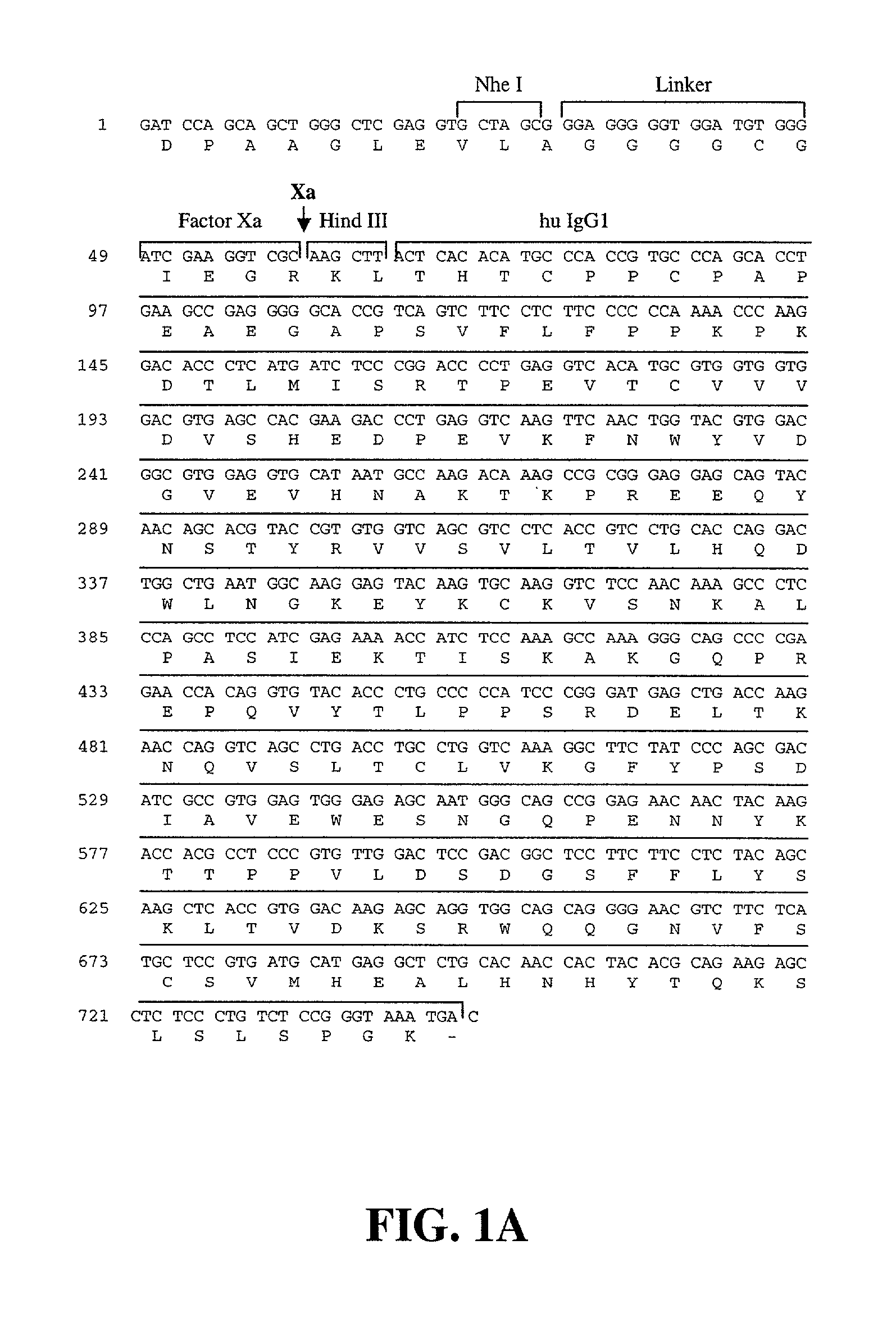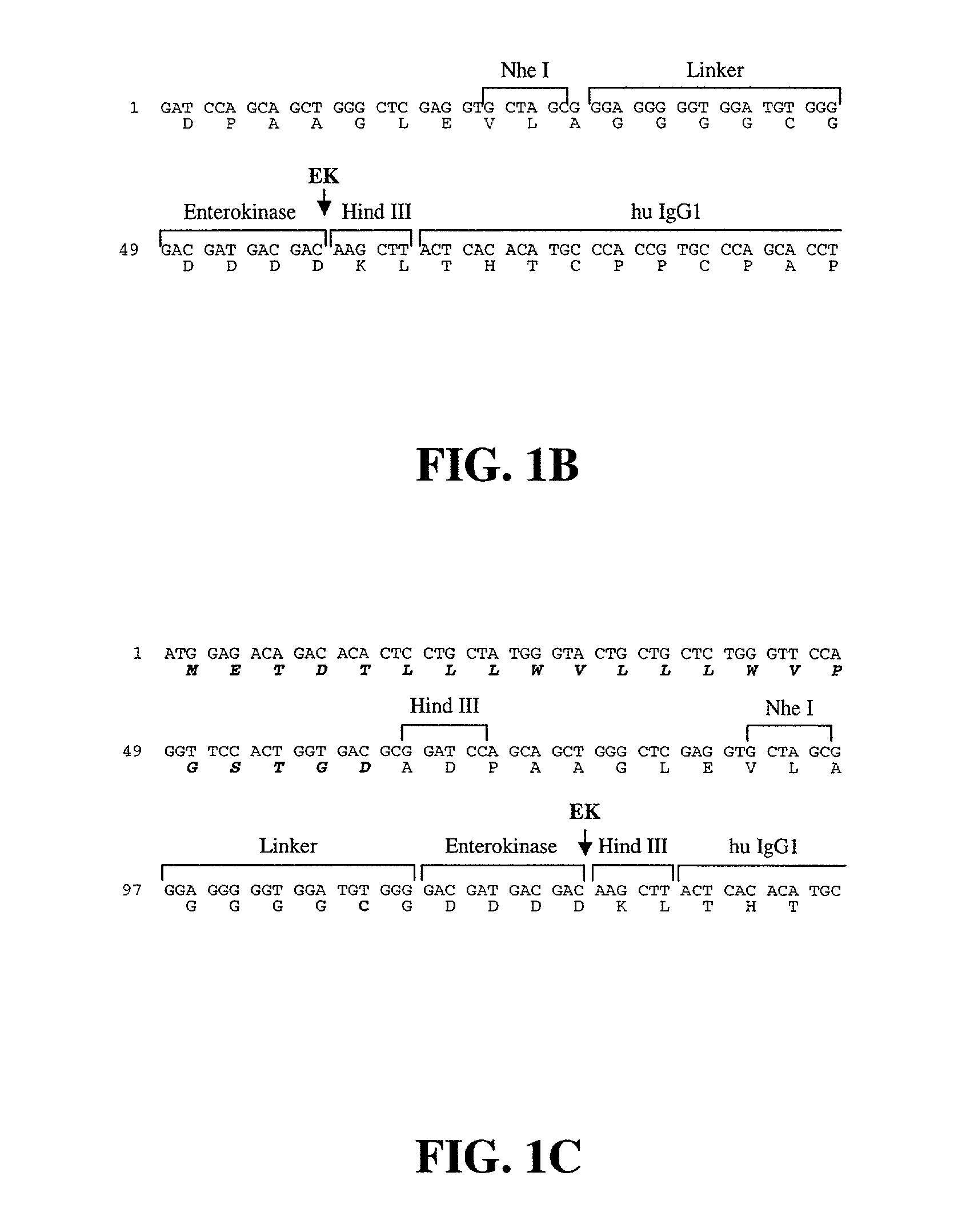Molecular antigen array
a technology of molecular antigens and arrays, applied in the field of molecular biology, virology, immunology and medicine, can solve the problems of insufficient administration of purified proteins alone, reduced extent and progression of neuropathologies, and difficult inducible immune responses against self-molecules, so as to inhibit the progression of prion-mediated diseases, prevent prion-mediated diseases, and reduce or eliminate the pool of follicular dendritic cells
- Summary
- Abstract
- Description
- Claims
- Application Information
AI Technical Summary
Benefits of technology
Problems solved by technology
Method used
Image
Examples
example 1
Modular Eukaryotic Expression System for Coupling of Antigens to VLPs
[0456]This system was generated in order to add various amino acid linker sequences containing a cysteine residue to antigens for chemical coupling to VLPs.
A. Construction of an EBNA Derived Expression System Encoding a Cysteine-containing Amino Acid Linker and Cleavable Fc-Tag:
[0457]pCep-Pu (Wuttke et al. J. Biol. Chem. 276: 36839–48 (2001)) was digested with Kpn I and Bam HI and a new multiple cloning site was introduced with the annealed oligonucleotides PH37 (SEQ ID NO:270) and PH38 (SEQ ID NO:271) leading to pCep-MCS.
[0458]A modular system containing a free cysteine flanked by several glycines, a protease cleavage site and the constant region of the human IgG1 was generated as follows. pSec2 / Hygro B (Invitrogen Cat. No. V910-20) was digested with Bsp120I and Hind III and ligated with the annealed oligonucleotides SU7 (SEQ ID NO:278) and SU8 (SEQ ID NO:279) leading to construct pSec-B-MCS. pSec-B-MCS was then d...
example 2
Eukaryotic Expression and Coupling of Mouse Resistin to VLPs and Pili
A. Cloning of Mouse Resistin:
[0467]Total RNA was isolated from 60 mg mouse adipose tissue using a Qiagen RNeasy kit according to the manufacturer's recommendation. The RNA was eluted in 40 μl H2O. This total RNA was than used for the reverse transcription with an oligo dT primer using the ThermoScript™ RT-PCR System (Life Technologies) according to the manufacturer's recommendation. The sample was incubated at 50° C. for 1 h, heated to 85° C. for 5 minutes and treated for 20 minutes at 37° C. with RNAseH.
[0468]2 μl of the RT reaction were used for the PCR amplification of mouse resistin. The PCR was performed using Platinium TAQ (Life Technologies) according to the manufacturer's recommendation using primers PH19 (SEQ ID NO:260) and PH20 (SEQ ID NO:261). Primer PH19 (SEQ ID NO:260) corresponds to positions 58–77 and primer PH2O (SEQ ID NO:261) to positions 454–435 of the mouse Resistin sequence. The PCR mix was fir...
example 3
A. Introduction of Cys-containing Linkers, Expression and Purification of Mouse Lymphotoxin-β
[0477]The extracellular part of mouse lymphotoxin-β (LT-β) was recombinantly expressed with a CGG amino acid linker at its N-terminus. The linker contained one cysteine for coupling to VLP. A long (aa 49–306) and a short version (aa 126–306) of the protein were fused at their N-terminus to either glutathione S-transferase (GST) or a histidine-myc tag for purification. An enterokinase (EK) cleavage-site was inserted for cleavage of the tag.
Construction of C-LTβ49-306 and C-LTβ126-306.
[0478]Mouse LTβ49-306 was amplified by PCR with oligos 5′LTβ and 3′LTβ from a mouse spleen cDNA library inserted into pFB-LIB. For the PCR reaction, 0.5 μg of each primer and 200 ng of the template DNA was used in the 50 μl reaction mixture (1 unit of PFX Platinum polymerase, 0.3 mM dNTPs and 2 mM MgSO4). The temperature cycles were as follows: 94° C. for 2 minutes, followed by 25 cycles of 94° C. (15 seconds), 6...
PUM
| Property | Measurement | Unit |
|---|---|---|
| composition | aaaaa | aaaaa |
| covalent bond | aaaaa | aaaaa |
| covalent | aaaaa | aaaaa |
Abstract
Description
Claims
Application Information
 Login to View More
Login to View More - R&D
- Intellectual Property
- Life Sciences
- Materials
- Tech Scout
- Unparalleled Data Quality
- Higher Quality Content
- 60% Fewer Hallucinations
Browse by: Latest US Patents, China's latest patents, Technical Efficacy Thesaurus, Application Domain, Technology Topic, Popular Technical Reports.
© 2025 PatSnap. All rights reserved.Legal|Privacy policy|Modern Slavery Act Transparency Statement|Sitemap|About US| Contact US: help@patsnap.com



